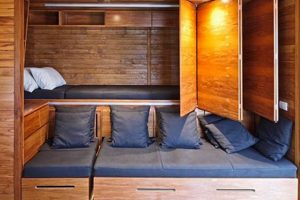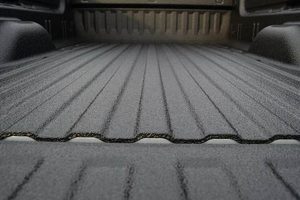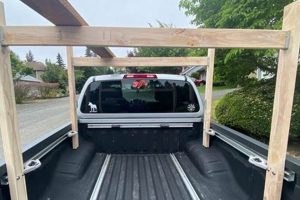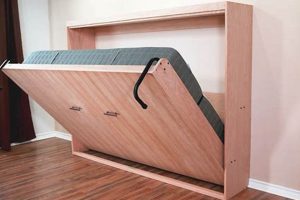A self-constructed wooden platform for a pickup is typically built by vehicle owners to replace or enhance the original factory bed. This structure can be crafted from various types of lumber, offering a customizable alternative to traditional metal truck beds. For example, a pickup owner might construct this type of platform to haul landscaping materials or equipment.
Constructing an alternative pickup platform can offer several advantages. It allows for tailored dimensions and designs, accommodating specific hauling needs that standard beds may not fulfill. Historically, such platforms were common before mass production standardized vehicle designs, showcasing individual craftsmanship and adaptation to local resources and requirements. This approach can yield cost savings, particularly when utilizing reclaimed or readily available lumber.
The following sections will delve into the materials selection, design considerations, and construction techniques necessary for the creation of a robust and functional platform. Topics will encompass frame construction, decking options, finishing processes, and safety measures to ensure a durable and secure implementation.
Construction Recommendations
The following outlines crucial guidelines for constructing a durable and safe wooden platform for a pickup truck. Adherence to these recommendations enhances the project’s longevity and functional integrity.
Tip 1: Lumber Selection: Employ pressure-treated lumber or naturally rot-resistant species like cedar or redwood for prolonged lifespan. Pressure-treated lumber withstands moisture and insect infestation, essential for an exposed truck bed environment.
Tip 2: Frame Reinforcement: Construct a robust frame utilizing appropriately sized lumber, typically dimensional lumber such as 2×6 or larger, depending on the intended load. Reinforce corners with metal brackets or gussets for increased structural integrity.
Tip 3: Secure Attachment: Use high-strength fasteners to secure the wood structure to the truck’s frame. Bolting through existing mounting points or welding to the frame (by a qualified professional) provides the most secure attachment.
Tip 4: Decking Installation: Space decking boards slightly apart to allow for expansion and contraction due to temperature and moisture fluctuations. This minimizes warping and potential damage to the structure.
Tip 5: Protective Coating: Apply a durable sealant or paint specifically formulated for exterior use. This protects the wood from UV damage, moisture penetration, and abrasion from cargo.
Tip 6: Regular Inspection: Routinely inspect the platform for signs of wear, rot, or loose fasteners. Address any issues promptly to prevent further deterioration and maintain structural integrity.
Implementing these recommendations contributes to a safer, more durable platform that meets the demands of regular use. Proper lumber selection, robust frame construction, secure attachment, and protective coatings are paramount.
With careful planning and execution, the construction of a functional and aesthetically pleasing wooden platform for a pickup truck can be achieved. The subsequent section details essential safety precautions to observe during the construction process.
1. Material Durability
Material durability constitutes a foundational consideration in the construction of a wooden platform for a pickup truck. The selected materials directly influence the structure’s lifespan, resistance to environmental factors, and overall structural integrity, impacting safety and long-term cost-effectiveness. Neglecting durability considerations results in premature degradation and potential structural failure.
- Wood Species Selection
The choice of wood species dictates the platform’s inherent resistance to rot, insect infestation, and moisture absorption. Species like pressure-treated lumber, cedar, redwood, or cypress exhibit enhanced durability compared to non-treated softwoods such as pine or fir. For example, untreated pine will rapidly decay when exposed to the elements, necessitating frequent repairs or complete replacement, thereby increasing the total cost of ownership.
- Protective Coatings and Treatments
Application of appropriate coatings, such as sealants, paints, or wood preservatives, provides a barrier against moisture, UV radiation, and physical abrasion. These coatings extend the lifespan of the wood by preventing water penetration and reducing the risk of cracking, warping, and fungal growth. Periodic reapplication of protective coatings is essential for maintaining the platform’s long-term durability.
- Fastener Corrosion Resistance
The selection of fasteners, including screws, bolts, and nails, directly impacts the structural integrity of the wooden platform. Corrosion-resistant fasteners, such as stainless steel or galvanized steel, prevent rust and degradation that can weaken joints and lead to structural failure. The use of non-corrosive fasteners is particularly critical in environments with high humidity, salt spray, or exposure to de-icing agents.
- Joint Design and Construction
The design and execution of joints significantly influence the overall strength and durability of the wooden structure. Properly constructed joints, such as mortise and tenon, lap joints, or butt joints reinforced with metal fasteners, distribute loads evenly and prevent stress concentrations that can lead to failure. Sloppy or poorly executed joints compromise structural integrity and reduce the platform’s load-bearing capacity.
The interplay of these elements determines the longevity and reliability of the self-constructed platform. Ignoring any single facet compromises the overall structural integrity and cost-effectiveness. Proper material selection, protective treatments, corrosion-resistant fasteners, and sound joint construction are integral to a durable, safe, and functional wooden platform for a pickup truck.
2. Frame Strength
Frame strength represents a critical parameter in the construction of a self-assembled wooden platform for a pickup. It directly dictates the load-bearing capacity, structural integrity, and overall safety of the completed installation. Insufficient frame strength leads to premature failure, jeopardizing both cargo and vehicle operation. For example, a frame constructed of undersized lumber or utilizing inadequate joinery will buckle under the weight of heavy loads, rendering the bed unusable and potentially causing damage to the vehicle.
The selection of appropriate materials and construction techniques is paramount to ensuring adequate frame strength. Dimensional lumber of sufficient thickness, typically 2×6 or greater depending on the intended load, forms the foundation. Proper joinery, such as mortise and tenon or reinforced butt joints, distributes stress effectively. Reinforcing corners with metal brackets or gussets provides additional stability. Furthermore, the method of attachment to the truck’s chassis significantly impacts the frame’s ability to withstand stress. Bolting through existing frame mounting points or welding (performed by a certified professional) provides the most secure and stable connection. Failure to adequately reinforce the frame can result in stress fractures, warping, and ultimately, structural collapse under load.
In summary, frame strength is an indispensable element in the design and execution of a wooden platform. Selecting appropriate lumber, employing robust construction techniques, and ensuring secure attachment to the vehicle frame are essential for a safe and functional structure. Compromising on frame strength negatively affects the platform’s load-bearing capacity, durability, and the safety of both cargo and vehicle, resulting in potentially costly repairs or complete failure. Prioritizing frame strength is therefore crucial to a successful project.
3. Secure Mounting
Secure mounting is an indispensable element in the successful implementation of a self-constructed wooden platform for a pickup truck. It directly influences the stability, safety, and overall performance of the structure, preventing displacement during vehicle operation and ensuring the secure transport of cargo.
- Attachment Points and Hardware
The selection and utilization of appropriate attachment points on the truck’s frame, coupled with high-strength fasteners, are critical for secure mounting. Existing factory mounting points offer a robust foundation. When these are unavailable, welding (performed by a certified professional) provides a permanent and reliable connection. The hardware used, including bolts, washers, and nuts, must be of sufficient grade and corrosion-resistant to withstand the stresses of regular use and environmental exposure. For example, using undersized or corroded hardware can lead to loosening or complete failure, compromising the security of the platform.
- Distribution of Load
The method of securing the wooden platform to the truck frame must ensure an even distribution of load. Concentrated stress at single attachment points can lead to localized failure and eventual detachment. Utilizing multiple attachment points, strategically positioned to distribute the weight of the platform and its cargo, minimizes stress on individual connections. Furthermore, reinforcement of the frame around attachment points can prevent deformation and ensure long-term stability. An uneven distribution of load, such as securing the bed to only the rear of the truck frame, could cause instability and detachment under heavy braking.
- Vibration Dampening and Isolation
Incorporating vibration dampening materials between the wooden platform and the truck frame can mitigate the effects of road vibrations and prevent loosening of fasteners. Rubber or polyurethane pads act as a buffer, absorbing vibrations and reducing wear on both the platform and the truck frame. This is particularly important for vehicles operating on rough terrain or carrying heavy loads. Neglecting vibration dampening measures can lead to accelerated wear, fastener fatigue, and eventual loosening of the platform.
- Regular Inspection and Maintenance
Regular inspection of all mounting points and hardware is essential for maintaining the security of the wooden platform. Fasteners should be checked for tightness, and any signs of corrosion or damage should be addressed promptly. Periodic tightening of fasteners and replacement of worn or damaged components ensures the continued stability and safety of the structure. A lack of regular inspection and maintenance can result in undetected issues escalating into significant problems, potentially leading to platform detachment and cargo loss.
These facetsattachment point integrity, load distribution, vibration mitigation, and consistent oversightdefine a reliable, safely mounted wooden platform. Proper execution of these principles ensures the long-term integrity and stability of the structure, contributing directly to its functionality and safety on the road. The principles of secure mounting are not merely suggestions but integral parts of the construction.
4. Weather Resistance
Weather resistance is a critical performance factor in the longevity and functionality of a self-constructed wooden platform for a pickup truck. Due to constant exposure to environmental elements, the platform’s capacity to withstand moisture, temperature fluctuations, and UV radiation directly impacts its structural integrity and service life.
- Moisture Penetration Mitigation
Moisture penetration is a primary threat to wooden structures. Unprotected wood absorbs water, leading to swelling, warping, and rot. Effective mitigation strategies include selecting naturally water-resistant wood species, such as cedar or redwood, and applying penetrating sealants or waterproof coatings. These measures create a barrier that prevents moisture from entering the wood’s cellular structure. For instance, a platform constructed from untreated pine will exhibit accelerated decay compared to one treated with a quality sealant, particularly in regions with high precipitation.
- Temperature Fluctuation Accommodation
Temperature fluctuations induce expansion and contraction in wood, leading to stress and potential cracking. Constructing the platform with appropriate expansion joints and using flexible adhesives can accommodate these dimensional changes. Employing fastening methods that allow for movement, such as slotted screw holes, further mitigates stress. An example of inappropriate construction would be tightly butted boards fastened without expansion gaps, which are likely to buckle or split under extreme temperature variations.
- Ultraviolet Radiation Protection
Prolonged exposure to ultraviolet (UV) radiation degrades lignin, a component of wood that provides structural support. This degradation causes the wood to turn gray, become brittle, and lose strength. Applying UV-resistant coatings, such as paints or stains with UV inhibitors, shields the wood from harmful radiation. These coatings slow down the degradation process, preserving the platform’s aesthetic appearance and structural integrity. Unprotected wood will show signs of UV damage more rapidly than surfaces treated with UV protectants.
- Protective Coating Maintenance
The efficacy of weather resistance measures depends on regular inspection and maintenance of protective coatings. Coatings degrade over time due to weathering and abrasion. Periodic reapplication of sealants, paints, or stains is necessary to maintain a continuous barrier against moisture, temperature fluctuations, and UV radiation. Neglecting maintenance allows environmental elements to penetrate the wood, negating the benefits of initial protective measures. A planned schedule of reapplication, coupled with thorough cleaning, will ensure sustained protection.
These considerations collectively determine the effectiveness of weather resistance in a do-it-yourself wooden platform. Adequate protection against moisture, accommodation of temperature fluctuations, shielding from UV radiation, and a maintenance schedule are pivotal. Proper attention to these details will extend the platform’s lifespan, preserve its structural integrity, and enhance its long-term value.
5. Load Capacity
Load capacity represents a critical design parameter when constructing a wooden platform for a pickup truck. The intended use of the platform dictates the required load-bearing capability. Exceeding the designed limit poses significant risks, including structural failure, damage to the vehicle, and potential safety hazards. Underestimation of load requirements compromises the functionality of the platform, rendering it unsuitable for its intended purpose. For example, a platform designed for light-duty hauling will likely collapse under the weight of construction materials such as concrete or lumber.
Calculating the necessary load capacity involves considering both the anticipated weight of the cargo and any dynamic forces, such as those experienced during acceleration, braking, and cornering. Safety factors should be incorporated to account for unforeseen loads or variations in material strength. The selection of lumber, joinery techniques, and fastening methods must align with the calculated load requirements. For instance, using undersized lumber or inadequate fasteners will compromise the frame’s ability to support heavy loads, irrespective of the quality of the wood itself. The type of wood, dimensions of the wood members, and spacing of support beams are factors. Failure to perform load capacity estimations can lead to structural compromise with risks to health and life.
In summary, a precise understanding of load capacity is paramount in the construction of a robust and safe wooden platform for a pickup truck. Accurate assessment of load requirements, coupled with appropriate material selection and construction techniques, ensures that the platform can reliably support the intended cargo without compromising structural integrity or safety. Adherence to these principles minimizes the risk of failure, protecting both the vehicle and its occupants.
Frequently Asked Questions
The following section addresses commonly encountered inquiries regarding the construction and implementation of wooden platforms for pickup trucks. Each question is answered with a focus on providing accurate and practical information to assist in informed decision-making.
Question 1: What lumber types offer optimal durability for a truck bed platform?
Pressure-treated lumber provides a cost-effective solution for resisting rot and insect infestation. Naturally durable wood species, such as cedar, redwood, or cypress, also offer excellent resistance to weathering. Lumber selection should reflect the intended use and environmental conditions to ensure longevity.
Question 2: How does one determine the appropriate load capacity for a platform?
Load capacity is calculated by estimating the maximum weight of anticipated cargo and incorporating a safety factor to account for dynamic forces. Consult load tables for the selected lumber type to determine safe load limits for specific spans. Overestimation is preferable to underestimation in assessing load requirements.
Question 3: What are the recommended methods for securely attaching the wooden platform to the truck frame?
Utilizing existing factory mounting points with high-strength bolts represents the preferred method. Welding, performed by a certified professional, provides a permanent attachment solution. Distribution of the load across multiple attachment points is essential to prevent stress concentrations and potential failure.
Question 4: What coatings provide adequate protection against weathering and UV exposure?
Exterior-grade paints, stains, and sealants formulated for wood offer protection against moisture and UV radiation. Periodic reapplication is necessary to maintain the integrity of the coating. Select coatings compatible with the chosen lumber type for optimal adhesion and performance.
Question 5: How can vibration and movement between the wooden platform and truck frame be minimized?
Employing vibration-dampening materials, such as rubber or polyurethane pads, between the platform and frame can mitigate vibrations. These materials absorb shock and reduce wear on fasteners. Regular inspection of fasteners is essential to detect and address any loosening caused by vibration.
Question 6: Is it necessary to obtain permits or inspections for constructing and installing a wooden platform?
Local regulations vary. Contacting the relevant transportation authority clarifies whether the construction or installation of a wooden platform requires permits or inspections. Adherence to all applicable regulations is imperative to ensure legal compliance.
These questions and their answers provide insights into key aspects of building a “diy wood truck bed”.
The subsequent segment will detail the necessary tools and equipment for the building process.
Conclusion
The preceding sections presented a comprehensive overview of factors relevant to the design and construction of a functional wooden platform for a pickup. Attention to material selection, frame strength, secure mounting, weather resistance, and load capacity is paramount. Adherence to sound construction principles ensures a durable and safe implementation of this project.
The creation of a durable and safe wooden platform demands meticulous planning and execution. Rigorous adherence to safety protocols and thorough consideration of structural integrity is non-negotiable. With diligence and informed decision-making, a “diy wood truck bed” can serve as a valuable and reliable asset for years to come.







